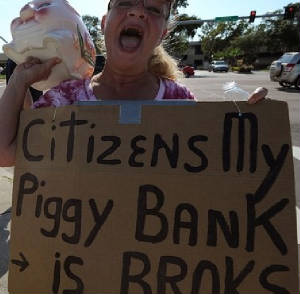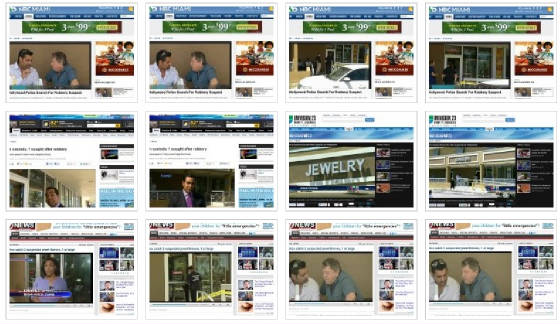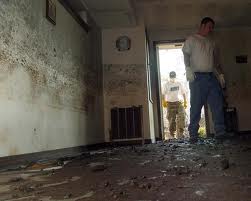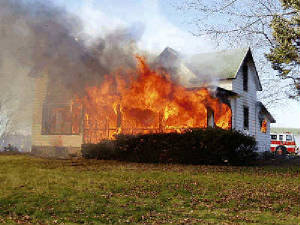Angry Homeowners To Citizens: We Are Paying
More But Getting Less ... [Wed, April 25, 2012] Dave Berman of Florida Today wrote a stimulating article regarding a recent meeting of 330 concerned residents in Barefoot Bay, FL on April 24th, 2012
to complain about insurance coverage on their manufactured homes.
[Wed, April 25, 2012] Dave Berman of Florida Today wrote a stimulating article regarding a recent meeting of 330 concerned residents in Barefoot Bay, FL on April 24th, 2012
to complain about insurance coverage on their manufactured homes.
The outraged homeowners packed a community center meeting room to express
their views on the latest rate hikes and the unjust changes to their policies. The meeting was a bit heated at times, and
at least some in the audience left the meeting unsatisfied.
One of the immediate concerns at Barefoot Bay is the decision by Citizens to discontinue offering
insurance coverage for carports and pool and porch screens, effective when policies are renewed this year. At the same time,
Barefoot Bay homeowners are seeing their Citizens premiums rise by an average of 10 percent this year. According to the article,
Barefoot Bay residents typically pay Citizens $1,500 to $2,600 a year to insure their manufactured homes.
Citizens Property Insurance Corp is the
state's largest property insurer with over 1.4 million customers. It was created to provide hurricane coverage to property
owners who could not get insurance from private carriers and lately it has been increasing rates while reducing coverage.
Anyone who
owns a house in Florida knows that property insurance has continued to rise, even without any major catastrophes in the past
seven years. Rates in Florida will now be more dependent on the insurance market, and if they happen to balloon, there isn't
much regulators can do about it. The state's catastrophe fund sells insurance to insurance companies. Right now it only has
enough cash on hand to cover one big storm over a 20-year period.
Citizens was supposed to be the insurer of last resort in Florida, but
ended up with a larger pool than expected. Citizens reported that its policy count is continuing to decline. As of March 31,
Citizens had 1.44 million policies, down 2.4% from the end of January – while total risk fell 10% over that period to
$503 billion. The reduction is due to private insurers removing policies, primarily from Citizens’ residential multi-peril
and wind-only books of business.
Citizens’ board also moved in February to reduce coverage for secondary structures, personal contents, new
construction and personal liability, as well as to increase sinkhole deductibles by 10%. As of May 1, Citizens is refusing
to insure properties valued at more than 1 million. Also no longer covered this year are most porches, decks and outbuildings.
I applaud the
residents of Barefoot Bay for voicing their concerns and standing up to Citizens. I also hope that in case of any damage sustained
to their homes they will elect to call an experienced and licensed Public Adjuster to ensure that they will get a maximum
settlement allowed by Citizens to fix or rebuild their homes.
I would love to get your thoughts and comments on this issue, and have you participate in
the blog. Do you have a policy with Citizens? What has your experience been like? Please leave a comment below or contact
me at joe@florida-pa.com.
Jewelry Heist, Zevuloni & Associates
Called For Help  [Fri, April 20, 2012] No doubt about it, getting a theft
claim settled quickly & successfully with an insurance company is not a simple task. However, after adjusting many such
claims, a pattern begins to emerge.
[Fri, April 20, 2012] No doubt about it, getting a theft
claim settled quickly & successfully with an insurance company is not a simple task. However, after adjusting many such
claims, a pattern begins to emerge.
To begin with, nearly all theft claims are looked at with suspicion – especially by the insurance companies.
Therefore the burden of proof, proper documentation, taking preventative measures, compliance with all requirements and clauses
of the insurance policy and fulfilling the duties right after the loss as stated in the policy are integral to a fair settlement.
Earlier this
week I was called to the scene of a jewelry store robbery. A robbery covered by the local media in the heart of a busy strip
mall in Hollywood, Florida. The Hollywood Police Department apprehended 3 suspects while the 4th one is still on the run (as
of this posting). All three had handguns and used stolen vehicles as the getaway cars.
Based on recent statistics, crime against jewelry
stores and firms result in losses over $125 million annually. On the average, 10-15 homicides occur annually during jewelry
store robberies. Jewelry stores are high-profile targets for robbers. Retail jewelers are at the greatest risk. I am confident
that my involvement and expertise will give the worried and frazzled owner of the jewelry store a piece of mind, justice and
a fair insurance settlement.
I welcome your comments or questions on this subject at joe@florida-pa.com. Stay safe! Below
are several photos of myself that were captured by the media at the scene of the crime.

The Definition of Property Damage [Thu, April 5, 2012] Property damage is defined on the
CGL form as: physical injury to tangible property, including all resulting loss of use of that property; and loss of use of
tangible property that is not physically injured. The loss of use is deemed to occur at the time of the physical injury (or
occurrence, when there is no physical injury) that caused it.
[Thu, April 5, 2012] Property damage is defined on the
CGL form as: physical injury to tangible property, including all resulting loss of use of that property; and loss of use of
tangible property that is not physically injured. The loss of use is deemed to occur at the time of the physical injury (or
occurrence, when there is no physical injury) that caused it.
There are several things to note about this definition.
Property damage under a CGL form pertains to tangible
property, that is, property that can be touched, property that is physical and material. For example: a book is tangible property,
an idea is not; a computer is tangible property, the information in the computer is not; a retail store building is tangible
property, goodwill engendered by good retail business is not. For property damage to occur, the property has to have an alteration
in appearance, shape, color, or some other material dimension, and that can only occur in property that is tangible.
There has been speculation (and some judicial
opinion) that computer data is tangible property since it can be put on a disk, edited, and transferred from one person to
another. However, in an effort to end that course of thought, the current CGL form specifically states that "for the
purpose of this insurance, electronic data is not tangible property." Electronic data includes information, facts, or
programs stored as or on, created or used on, or transmitted to or from computer software. Also, the current CGL form has
an exclusion applying to damages arising out of the loss of, loss of use of, damage to, corruption of, inability to access,
or inability to manipulate electronic data. This should clear up the issue of whether computer software data is tangible property
that could be covered as property damage under a CGL form, although whether this definition and exclusion will satisfy courts
as the information age progresses remains to be seen.
Another notable point is that property damage includes loss of use of tangible property, even
if there is no physical injury to the property. If physical injury to tangible property occurs, then the loss of use of that
property is automatically included within the definition of property damage. For example, if the insured negligently crashes
his mobile equipment into someone's retail store, the physical injury to the store is property damage covered under the CGL
form, and the resulting loss of use of that store by the owner is also property damage covered under the CGL form. But, what
if the loss of use of the tangible property occurs when there is no actual physical damage to the property? This part of the
definition can be more troublesome than the first part in that different courts can interpret "loss of use" differently.
Examine the following cases for some examples.
In Hendrickson v. Zurich American Insurance Company, 72 Cal. App.4th 1084 (1st Dist. 1999),
an insured commercial nursery brought suit against its insurer for breach of the duty to defend in a case where the insured
was sued by growers over defective plants that failed to produce a full crop; the plaintiffs in the complaint against the
insured alleged that they were damaged by a loss of use of tangible property due to the defective plants that the insured
sold to them. The court of appeals decided that the loss of use suffered by the growers did constitute property damage as
defined on the insured's CGL form even though their land was not physically injured. The court found that the growers"
complaint could be reasonably construed as alleging that, as a result of the insured's negligent delivery of defective plants,
the growers suffered a loss of strawberry production, and thereby a loss of use of their land. The court concluded by saying
that loss of profits and diminution in property value allegedly suffered by the growers in this case as a result of the defective
plants were not solely economic losses—which are outside covered property damage in liability policies—but are
damages because of property damage, and constituted alternative measures of property damage.
Hartzell Industries, Inc. v. Federal Insurance Company,
168 F. Supp. 2d 789 (S.D. Ohio 2001) is a case where the insured brought an action against the insurer, seeking indemnification
of its liability in an underlying action. Hartzell supplied the Allegheny Power Company with seven roof fans to cool its boiler
house. The propellers on one of the fans disintegrated and Allegheny shut down all the fans as a precaution; this led to lost
worker productivity due to the hot work environment attributable to the lack of functioning roof fans. The power company filed
a lawsuit against Hartzell for damages, and Hartzell tendered the claim to Federal. Then, the dispute over coverage began.
Hartzell said
that there was a property damage claim because Allegheny lost the use of tangible property—its boiler house—even
though that tangible property was not physically injured. Federal countered that Allegheny did not lose the use of its boiler
house as a result of the fan failure, but merely lost the use of the fans; and, since the fans were the only tangible property
that could not be used, the insurer said that Hartzell could not establish property damage based on the loss of use of tangible
property that is not physically injured. Federal also said that Allegheny's alleged damages resulting from reduced worker
productivity due to heat in the boiler house are purely economic losses which do not constitute the loss of use of tangible
property. The court found Federal's arguments to be unpersuasive.
The district court noted that Allegheny's complaint against Hartzell
was that its boiler house became too hot as a result of the inability to use Hartzell's roof fans. This, the court found,
qualified as a covered loss of use of tangible property that is not physically injured. The boiler house became less useful
because the fans were turned off and this resulted in a loss of productivity for Allegheny. This loss of use constituted property
damage as defined on the CGL form.
Another case is American Mercury Insurance Group v. Urban, 2001 WL 1723734 (D. Kan. 2001). (Note that this case
is not reported in F.Supp.2d.) This was a declaratory judgment action to determine whether American Mercury Insurance Group
had a duty to defend and indemnify its insured, Meadows General Contracting. Urban purchased a wet bin and a grain dryer and
arranged with Meadows to construct and install these and other parts and components of Urban's grain handling facility. Meadows
started the work but could not complete it, so Urban hired another construction company to do that. After a while, Urban put
5,000 to 6,000 bushels of shelled corn into the facility, but the concrete pad upon which the wet bin sat and which was poured
by Meadows settled and the wet bin tilted. Urban filed a lawsuit against Meadows alleging that the unexpected, sudden and
accidental tilting of the wet bin resulted in his being able to fill the wet bin to only one-third of its capacity, which
meant that the grain handling facility was able to operate at only one-third capacity; in other words, the loss of use of
the wet bin damaged Urban's grain handling facilities as a whole. Urban charged that the tilting was caused by Meadow's inadequate
and negligent design of the concrete pad.
Meadows tendered the lawsuit to its insurer, but American Mercury filed a declaratory judgment action, saying that
Meadows' policy did not cover claims made by Urban. Urban asserted that the damages he claimed related to the partial loss
of use and the resultant diminished value of his entire grain handling facility, and that this was property damage as defined
on Meadows policy. This court, however, found that the definition of property damage did not extend coverage to intangible
injuries such as Urban's partial loss of use of his business. In other words, loss of use of tangible property that is not
physically injured does not describe the loss that Urban suffered in this instance. Judgment was entered in favor of the insurer.
In Advanced
Network, Inc. v. Peerless Insurance Company, 119 Cal.Rptr.3d 17 (2011), the Court of Appeal, Fourth District, Division 1,
California held that the permanent loss of cash was not covered under the CGL form's loss of use provision. In this case,
the servicer of cash distribution machines in credit unions brought an action against its commercial general liability insurer
for breach of contract after the insurer denied coverage for a claim arising out of a theft of cash by the servicer's employee
from a credit union client. The appeals court ruled that this action was not for the "loss of use" of the cash,
but rather was for the permanent "loss" of the cash (the property) and its replacement value; thus, this claim was
not covered under the loss of use section of the definition of property damage as claimed by the insured. The court noted
that the terms "loss of use" and "loss" are not interchangeable for liability insurance purposes.
These cases show that "loss of use",
when there is no physical injury to tangible property, can be subject to a case by case judicial interpretation. However,
logic would seem to say that if the claimant cannot use his tangible property because of the negligence of the insured, that
sometimes can be seen as within the bounds of the definition of property damage on the CGL form.
One final point to note about the property
damage definition: the loss of use is deemed to occur at the time of the physical injury or occurrence that caused it; this
pertains to which policy applies to a property damage loss.
Now, there is general agreement that property damage occurs at the time the damage is discovered
or when it has manifested itself. For example, see Wrecking Corporation of America, Virginia, Inc. v. Insurance Company of
North America, 574 A.2d 1348 (D.C. 1990); and see Travelers Insurance Company v. Eljer Mfg., Inc., 757 N.E.2d 481 (Ill. 2001).
However, what if the property damage occurs in a policy period that ends in 2001, for example, but the actual loss of use
of the property because of the damage occurs in 2002, after a new policy period has begun? Which policy should cover the loss
of use? Since the definition on the CGL form now says that the loss of use occurs at the time of the physical injury or occurrence
that caused it, the answer is simple: the policy in force at the time the property damage occurs also applies to any resulting
loss of use, no matter when that loss of use occurs.
An example of this is Mitchell, Best, & Visnic, Inc. v. Travelers Property Casualty Corp.,
121 F. Supp. 2d 848 (D. Maryland 2000). In that case, an insured builder of custom homes sued its insurer, seeking coverage
for claims by home purchasers who alleged negligent misrepresentations on the part of the insured. One of the defenses of
Travelers was that the claimed damages did not occur during the policy period. Travelers" policy with Mitchell ran from
January 1, 1998 through January 1, 1999, and the alleged misrepresentations by the insured did occur during that time. However,
Travelers argued that the only real damages that may occur would do so in the future, if the houses under construction need
to be modified and repaired; thus, any damages would occur outside the policy period. The district court did not agree.
The court reviewed the policy and said
that the definition of property damage states clearly that the loss must occur at the time of the occurrence that caused it;
in order for the insured to be covered, the occurrence must take place during the coverage period. The court found that the
occurrence was the alleged negligent misrepresentation by the insured. This took place during the policy period, and any damages
from this alleged misrepresentation occurred during the policy period, even though any costs resulting from the misrepresentation—that
is, modification of homes to satisfy restrictive covenants—would be incurred in some future time outside the policy
period.
After The Fire, Everything Changes.  [Mon, April 1, 2012] In my line of work, I've unfortunately
witnessed many fires that have damaged or destroyed homes, emotionally paralyzing property owners and effecting all aspects
of the life they used to know. A fire is one of the most devastating things a person or family can go through, particularly
as a homeowner. If not brought under control quickly, a fire can destroy everything a person has, leaving him or her with
a long road to recovery.
[Mon, April 1, 2012] In my line of work, I've unfortunately
witnessed many fires that have damaged or destroyed homes, emotionally paralyzing property owners and effecting all aspects
of the life they used to know. A fire is one of the most devastating things a person or family can go through, particularly
as a homeowner. If not brought under control quickly, a fire can destroy everything a person has, leaving him or her with
a long road to recovery.
When fire strikes, lives are suddenly turned around. Often, the hardest part is knowing where to begin and who to
contact. According to FEMA, each year more than 2,500 people die and 12,600 are injured in home fires in the United States,
with direct property loss due to home fires estimated at $7.3 billion annually.
House fires are routine for local newspapers, insurance companies, mitigation
companies and industry specialists such as Public Adjusters. Less common are stories that come from the heart and explore
the lasting effects of such a personal disaster. In the series of beautifully and candidly written accounts, homeowner and lawyer Jenifer Ackerman describes what happened after her family's home was destroyed by fire in 2010.
Sadly Mrs. Ackerman's experience with her insurance company is not an isolated incident and is typical of what homeowners often face after loosing all that
is near and dear to them.
Most people are unprepared to say the least, and most likely think that it will never happen to them. A home fire
can cause extensive damage and recovering is not always easy. I have put together several very helpful links to external sources
that may be helpful to you to learn more about house fires - the before, during and after if it happens to you. Aside from
the reading materials below, please feel free to contact me at joe@florida-pa.com or call me at 954-742-8248 or toll-free at 877.ZEVULONI for a free consultation regarding your insurance policy, property
damage or any denied or underpaid claims.
I hope that you never experience a fire in your lifetime, but if you do, it is important
to know that you are not alone and that help is out there. Keep safe.